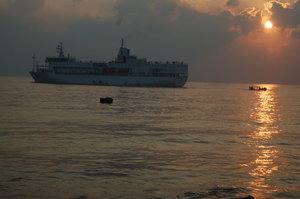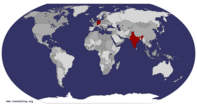Advertisement
Published: January 5th 2009

 Disembarkation without a jetty
Disembarkation without a jetty
Boats transport passengers from MV Kavaratti anchored off Kalpeni Island. The ship is still swaying. A green line of land is visible through the cabin window. Clockwork flashes from the light house illuminate the pre-dawn grey sea. A public address system tells the passengers to be ready to disembark at Kalpeni. There are no ladders leading to the jetty, there is no jetty to land, and there is no land. MV Kavarathi is anchored a mile or so off the coast, from where mechanized boats dart towards the ship. For freshers, the adventure is about to begin. For islanders it’s homecoming.
The 2.79-square kilometre atoll is surrounded by a 25.60-square kilometre shallow lagoon which keeps big vessels at bay. Watertight doors at deck 1 are opened. We get ready to disembark - to a boat bobbing with the waves. Asif Azad and M P Masood, our hosts, help us in the mid-sea manouvre. We crouch into the centre of the boat to enjoy the red sun on one side and the green water on the other.
Three days later, as I was wondering why I never bothered to visit Lakshadweep despite its closeness to my hometown Kochi, Murthasa told me: “There’s a sea separating us.” My islander-friend was true

 Mid-sea manouvre
Mid-sea manouvre
Coral reefs around the island keep big vessels at bay. to the last syllable. I discovered that I could be left clueless by two persons speaking my mother tongue, that currency notes and locks are redundant in the islands, that combinations of tuna and coconut made a magnificent menu, that the green-blue lagoons of Lakshadweep were not Photoshop-enhanced fakes.
Asif invite us home for breakfast. “Hope you are not vegetarians,” he says. Delma and I laugh away the doubt. Rice pathiri soaked in coconut milk, rice puttu laced with coconut flakes, red chilly tuna curry seasoned with vinegar, less spicy lagoon fish curry and of course, black tea. The islanders’ cultural connection with the Malabar is most certainly reflected in cookery. Though the dishes are common in any Muslim household in north Kerala, there are marked differences in taste. There’s an abundance of coconut in every item, except tea. Coconut water or coconut milk is easy to get than drinking water. Even rice is boiled in coconut milk.
While larger islands like Kavarathi have put up desalination plants to avail of drinking water, natives in other islands draw hard water from shallow wells. Some panchayats have turned to rainwater harvesting. The islands don’t have a single stream. Outside

 Tip beach
Tip beach
The blue lagoon and the bluer seaAsif’s house stands the diesel power plant which supplies electricity to the whole of Kalpeni Island. We stroll down the street. Old houses built from odd-shaped sea rocks slowly give way to modern houses. Asif supplies cement, steel and other construction materials to the islanders, most of whom find livelihood in government service.
We go to the police station, where cops are planning the New Year celebration. Any outsider is required to get a permit to visit Lakshadweep islands and he/she must get it stamped at the local police station within 24 hours after arriving in any of the islands. The 21-man police station and the reserve battalion unit adjacent to it seem to be out of place in the island. “There are very few crimes reported here. The only cases we get are political clashes,” the constable says. The lock-up is used as a store room.
Tourists, however, are relieved of the hassles if they choose any of the packages offered by Lakshadweep Tourism. While the large batch of tourists - our fellow passengers on board MV Kavarathi - are led to the lagoon for boating and snorkeling, we ride to the other tip of the island

 Blue lagoon
Blue lagoon
The shallow water is home to unique coral reefson a friend’s bike. The ‘Tip Beach’ is sandwiched between the blue lagoon and the bluer sea. Sooty terns look for fish as water retreats from the beach. “I doubt if I had been to a more beautiful place,” Delma says.
Lakshadweep, the smallest Union Territory in India, is an archipelago of 36 islands, which together make up 32 square kilometres. As per 2001 census, 60,595 people inhabit ten of these atolls scattered in the Arabian Sea. The rest of the islands - one was partly leased to a hotel chain recently - are home to terns and migratory birds. In the biggest island - Androth - 10,720 people inhabit 4.90 square kilometre while in Bitra, 264 prople live on 0.10 square kilometre. The lagoons surrounding each of these islands, however, span over thousands of square kilometers, luring tan seekers and scuba divers.
We fuel the bike at a provision store. No petrol pumps in this island. There are offices of public works department and agriculture department lining the metre-wide concrete road. Even an indoor stadium is coming up. There are four schools in this island and almost every child goes to school. It’s exam time.
We

 Friendship home
Friendship home
Ayishabi's smile eclipses her traditional jewelleryvisit at least three houses before lunch at Akbar’s house. “These are the houses where I stay when I come to Kalpeni,” says Masood, who hails from Amini Island. We convince Masood’s hosts (ours too) to limit the treat to sharbat or tender coconut water. “Here everybody knows everybody. If I don’t take you to their houses, they will be cross with me,” Masood says. Every islander has changathapuras (friendship homes) in every other island. These liaisons are inherited from the time of their great grandfathers, fishermen or sailors stranded on an island till the sky cleared and the sea calmed.
The interdependency continues even today. The ten islands are connected by six ships and a few speed vessels that cancel voyage at the slightest turbulence. To reach home, an islander has to halt at another island for a day at least. Take Masood’s case for instance. He boarded MV Kavarathi from Kochi the previous evening. Today the ship halts at Kalpeni and resumes voyage to Minicoy in the evening. Tomorrow evening it will leave Minicoy for Kavarathi. The tedious journey is not a problem for him because he has friends in Kalpeni, Minicoy and Kavarathi, where he has

 Masjid of djinns
Masjid of djinns
The Muhiyuddin masjid on the southern part of Kalpeni is believed to be built by djinns.to wait for the next vessel to take him home to Amini. The mutualism has become the islander’s signature.
Masood will find himself low if we - his guests - eat at a restaurant. His friends will find it offensive if he had to buy us food. If you are an islander’s guest, you are the guest of the whole island. My mainland urban psyche found it hard to digest.
After lunch, we go to the lagoon with Ikbal, Naseema and their younger son Ihthisham, who is an expert swimmer at four years. On the way we visit a masjid built by fairies. “This mosque was not built by humans. Long ago, people planned to construct a mosque here. They dug up the place to construct the basement. When the workers returned the next day they found the mosque at the same site. It was built overnight by the djinns,” Naseema, a member of Kalpeni panchayat, says. Miracles don’t end there. Of the seven ponds surrounding the masjid, one provides drinking water despite its proximity to the sea.
By the time we reach the lagoon, Ihthisham’s elder brother Anwar joins us after exams. Half the tourists are sleeping in the huts or waiting for their companions to return from the 'village visit' organised by the tourism department. The shallow water is ideal for glass boating and snorkeling. We reserve it till the next morning. The lagoon is as placid as a swimming pool. Delma is still fascinated by the playful sea on the other side of the island, where she went with Naseema before lunch. Monotonous lagoon can wait.
The sea is irresistible. We face the punishing waves. Sailfish surf through a translucent wall of water over our heads. Each wave sweeps us over sharp corals. We return to Naseema’s house with bruised palms and feet. MV Kavarathi has returned after a detour to Androth Island. In a while, the ship will resume its voyage to Minicoy with the large batch of tourists and other passengers. We decide to stay back in Kalpeni and board a speed vessel scheduled to depart to Kavarathi tomorrow.
As we sip black tea and rest our tired feet, Masood breaks the news: the speed vessel won’t leave until day after tomorrow. The fuel tanker hasn’t come yet. We make some panic calls. But to no avail. This is the waterworld. “In the islands money can’t take you anywhere. You need to know people,” Asif had declared in the morning. Curiously, he is able to get us on board MV Kavarathi again, minutes before the ship lifted its anchor. We were chasing the ship, literally. The skilled boatman kept his boat abreast to help us jump inside the ship to Minicoy. An unforgettable way to end the year.
Dinner is ready. The menu is nowhere near what we were promised at Akbar’s house. Tired after the sea bath, we hog whatever we get. We retreat from the New Year party to quietly feel the sea rocking us. New Year’s Eve was rocking, in its original sense.
Advertisement
Tot: 0.113s; Tpl: 0.015s; cc: 11; qc: 66; dbt: 0.0713s; 1; m:domysql w:travelblog (10.17.0.13); sld: 1;
; mem: 1.2mb











Rohini
non-member comment
Sniff...
Enikkum pokanam...